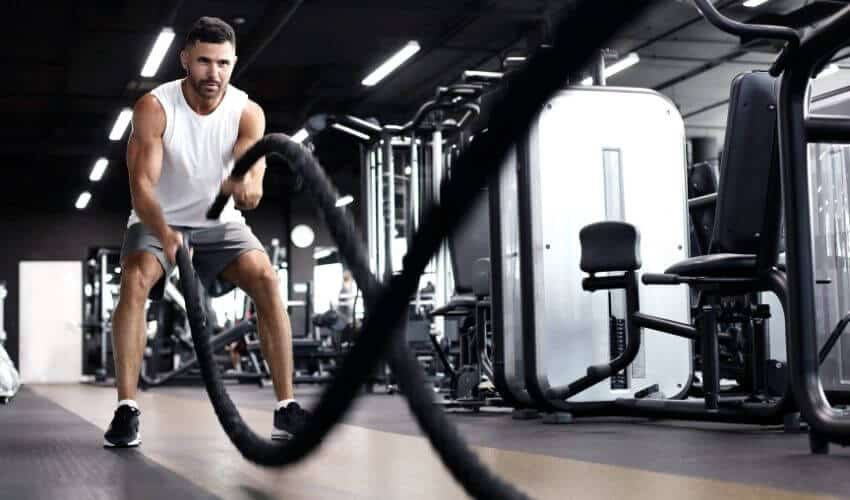Whether we’re a marathon runner or just jogging outdoor, having a good endurance level is critical for doing the work efficiently and become overall well-being.
Generally, endurance is our body’s capacity to doing an activity for an extended period.
Lacking endurance may cause several adverse effects, such as feeling tired after a bit of exertion, lack of energy or focus, mood off, and low self-confidence.
In this article, we’ll go through how to build endurance naturally with seven proven tips. We’ll also learn how to measure it and the best exercises that we can perform to increase our endurance level.
What is Endurance
Endurance is our physical capability to sustain an exercise for a prolonged period.
Generally, it’s made with two elements: cardiovascular endurance and muscular endurance.
Cardiovascular endurance is our heart, lungs, and blood vessels’ ability to supply oxygen to the working muscles during physical activity.
And muscular endurance refers to our muscle or muscle groups capacity to sustain in a repetitive motion or contraction for an extended period without fatigue.
We’ll learn how you can measure and improve different types of endurance later on in this article.
Top 10 Benefits of Building Endurance
Let’s have a look at the top ten benefits we’ll get by building endurance.
- Increases our ability to do regular activities more efficiently.
- Keeps our heart and lungs healthy, which reduces many diseases such as diabetes, heart disease and stroke.
- Keeps our bones and joints healthy and reduce future injuries.
- Helps to maintain healthy body weight.
- Improves blood circulation throughout the body.
- Keeps you energetic and motivated to do your work.
- Improves your self-image and how you feel about yourself.
- Enhance your sleep quality and overall health.
- It helps your body to become better able to produce ATP through aerobic metabolism.
- It gives you better peace of mind and also helps to overcome depression.
We can see that having a good endurance level isn’t only helps to improve workout performance but also enhance our overall health and well-being. (1)
7 Tips on How to Build Endurance Naturally

Follow these seven tips or tactics to boost your endurance level.
1. Run Long and Slow
To increase endurance, we have to run farther.
Whatever our current endurance level, we should increase the training time by 5 to 10 minutes or add 0.5 to 1 mile every time to challenge our physical ability for growth.
First, start your run slowly and focus on covering the distance.
The gradual-adaption principle is deeply connected to human physiology, and it worked very well for millions of athletes.
So, what you should do is, whatever your fitness or endurance level, begin with slow but steady.
This means you can increase 1 mile a week to your weekend—for example, 5 miles, 6 miles, 7 miles. Then, every 4th week, reduce the milage by skipping your run, take a rest/recovery day.
Next week start increasing 1 mile at a time again: 8 miles, 9 miles, and so on.
This way you’ll gradually challenge yourself and force your body to improve stamina and endurance.
2. Low Intensity, High Repetition
Low intensity, high repetition is another great way to build muscular endurance because low power, high rep workouts train our body for repetitive motion.
It helps build muscle endurance and definition that transfer the benefits over the other activities like heavy lifting, running, cycling to give you a pick performance all-around.
3. Consume Right Diet
When we talk about increasing endurance, two nutrients that majorly influence our endurance level are carbohydrates and caffeine.
You should consume 50%-60% calories from carbohydrates from your required daily calories.
Having complex carbs with little protein before a workout is crucial to enhance your workout performance for prolonged intensive training.
Here’re the best carb sources you can eat:
- Barley
- Quinoa
- Potato
- Oatmeal
- Beans
- Fruits
- Whole-wheat bread, etc.
The second ingredient that boost performance is caffeine which you can take from coffee or supplements.
Caffeine helps to improve our focus, concentration and endurance for a prolonged workout.
You can take one cup of black coffee 20-30 minutes before an activity without any sugar or artificial flavours.
However, You shouldn’t rely on these two ingredients only. A balanced combination of protein, carbs, and fats is essential for improving workout performance and building endurance.
Related: 50 Healthy Pre-Workout Snacks to BOOST Performance
4. Recover Well
No matter how hard you train, if you’re not giving your body adequate time to recover, you’re probably missing something significant that minimize your results.
A good recovery comes from a good diet, sufficient rest and sleep.
Our aim should be to eat quality meals throughout the day and get about 7 hours of sleep to maximize our recovery and build endurance fast.
5. Change Your Workout
Following the same routine over the months can limit your gain and even can ruin your endurance and muscle growth.
So, instead of growing comfortable with a specific workout plan, you should consistently challenge yourself by changing your workout plan after every 2-3 months.
Try to mix up your regular workout routine, or you can experiment with different workout programs to challenge your body and break your comfort zone.
Related: The PERFECT 3-Months Beginner Workout Plan
6. Be Consistent
Consistency is the key to success, no matter what you’re trying to achieve.
To increase your cardiovascular capacity and muscular endurance, you need to exercise consistently and take the right diet while eliminating unhealthy foods.
Consistent training increases our aerobic capacity and strengthens our muscles so that we can train farther than before.
Whatever workout plan you’re following, stay consistent with your schedule and try to regular workout no matter it’s just a 10-minute mini-session or 60 minutes long.
7. Mind Game
Using the conscious and subconscious mind is one of the critical and intelligent ways to improve endurance.
“Our minds are the key to either pushing our bodies or stopping short,” says Giovinazzo.
Exercising or running slightly more than you usually do might be challenging or very easy; it depends on how well you train your brain.
For example, make a challenging workout or activity with a few smaller ones to feel less tough.
Suppose you want to run 5 miles. Some way to make it less daunting is to break it down to 1 mile at a time or break it down like 3 miles fast with slow 2 miles to make it less scary than running all 5 miles.
Tip: Imagine in the night before sleep and first in the morning that you’re following the above ways consistently and your endurance levels are improving significantly. And within a few weeks, you’ll see the magic of your mind.
How to Measure Cardiovascular Endurance
Like I said before, cardiovascular endurance is your heart and lungs’ capacity to supply oxygen to your working muscles during a workout.
Generally, there’re four different methods you can use to estimate your cardiovascular endurance or maximal oxygen uptake (VO2 max), such as:
- Treadmill test
- Ergometer
- Step test
- Predicted VO2max (Astrand-Rhyming)
Okay, but how can you measure your VO2 max at home?
Simple, by following the step test formula called “Harvard step test” to calculate VO2 max.
Harvard Step Test:
- Take a bench or platform at the height of about 50 cm (20 inches) for men and 40 cm (16 inches) for women.
- You repeatedly step onto and off the platform in a cycle of two seconds, which means 30 steps per minute.
- Must be sustained for five minutes and then immediately sits down.
- Next, count your heartbeats 3 times: 1 to 1.5, 2 to 2.5, and 3 to 3.5 minutes.
- This means you measure your heart rate three times, but not for a minute, only for 30 seconds each time.
Now, scoring the test:
- Short-Form Equation – Fitness Index = (100 x test duration in seconds) divided by (5.5 x pulse count between 1 and 1.5 minutes).
- Long-Form Equation – Fitness Index = (100 x test duration in seconds) divided by (2 x sum of heartbeats in the recovery periods).
The outcome of the equation is rated as follows:
| Rating | Fitness Index |
|---|---|
| Excellent | >96 |
| Good | 83-96 |
| Average | 68-82 |
| Low average | 54-67 |
| Poor | <54 |
Test yourself and compare your VO2 max level.
If it falls in the excellent category, then congratulation!
But if it’s poor or low, you should definitively follow the tips discussed above and start doing the exercises mentioned below to boost your cardiovascular endurance levels.
Top 5 Exercises to Improve Cardiovascular Endurance
Here’re the top 5 exercises to improve your cardiovascular endurance fast.
1. Jump Rope

How to do it:
- Stand with your feet together and keep a rope in your hands.
- Turn the string with its handles while jumping over it.
- Continue the process and make sure you are turning the cord using your wrists, not your hands.
Why: Jumping rope is a great cardio workout that burns around 220 calories in 20 minutes. It is effortless to carry, inexpensive, and can perform anywhere you have space.
2. Jumping Jack

How to do it:
- Stand with your legs together and arms at your sides.
- Jump and spread your feet wider than shoulder-width while circling the arms overhead.
- Jump and back to the starting position. Repeat.
Why: Jumping jack is an excellent exercise that engages both your upper and lower body, making it more impactful to increasing your heart rate and burn more calories efficiently.
3. Burpees

How to do it:
- Stands with your legs together and arms at your sides. Squat and place your hands on the floor.
- Jump your feet to a plank position. Do one push-up.
- Jump back your feet into a squat. Jump up, reaching your arms upward. Repeat.
Why: Burpee is an excellent exercise for building endurance. It involves a squat, jump, and pushup — engage your entire body and burns about 100 or more calories in 10 minutes of workout.
4. High Knee

How to do it:
- Stand with your legs together and arms slightly bent at your sides.
- Bend your knee and lift it towards your chest.
- Return your leg to the floor and repeat with another leg.
- Continue alternating legs as fast as possible while moving your arms up and down at your sides.
Why: High-knee running increases your heart rate while strengthening your lower body. It is a very effective cardio exercise to burn calories in the least amount of time.
5. Mountain Climber
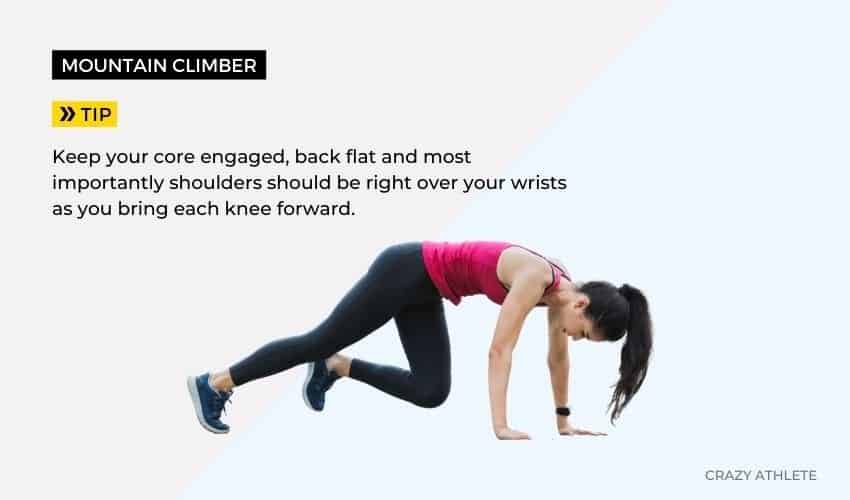
How to do it:
- Start in a plank position with your hands firmly placed on the ground under your shoulder.
- Keep your body straight along with your back and core.
- Next, run your knees in and out from a push-up position, and continue.
Why: Mountain climber helps to raise your heart rate while increases endurance and strength of your core, wrist, and shoulders.
How to Measure Muscular Endurance
As we already know, muscular endurance is the ability of a muscle or a group of muscles to repeatedly contract over a long period without fatigue.
Now, let’s look at an example of a pushup muscular endurance test which you can test yourself at your home to know your upper body muscular endurance.
First, we’re going to do a little bit of warm-up for about 5-10 minutes, and then we move into the test.
Muscular Endurance Push-Up Test
- Start with the pushup position. Keep your body straight from head to heels, legs together, and hands placed on the floor at a shoulder-width apart.
- Bend your elbow at about a 90-degree angle and lower your chest towards the floor.
- Push back with your arms to the starting position. Repeat that up and down movement.
- Count how many you get done and in the end, we’re gonna take the total numbers.
Now compare the score accurately to the normative data.
| Age (Male) | Poor | Fair | Average | Good | Excellent |
|---|---|---|---|---|---|
| 20-29 | <20 | 20-34 | 35-44 | 45-54 | >54 |
| 30-39 | <15 | 15-24 | 25-34 | 35-44 | >44 |
| 40-49 | <12 | 12-19 | 20-29 | 30-39 | >39 |
| 50-59 | <8 | 8-14 | 15-24 | 25-34 | >34 |
| >60 | <5 | 5-9 | 10-19 | 20-29 | >29 |
| Age (Female) | Poor | Fair | Average | Good | Excellent |
|---|---|---|---|---|---|
| 20-29 | <6 | 6-16 | 17-33 | 34-38 | >48 |
| 30-39 | <4 | 4-11 | 12-24 | 25-39 | >39 |
| 40-49 | <3 | 3-7 | 8-19 | 20-34 | >34 |
| 50-59 | <2 | 2-5 | 6-14 | 15-29 | >29 |
| >60 | <1 | 1-2 | 3-4 | 5-19 | >19 |
Muscular Endurance Squat Test
Okay, now it’s time to test our legs/lower-body muscular endurance, and we’ll do that by doing bodyweight squats.
- First, you need to warm up for about 5-10 minutes to increase the blood circulation of the muscles and reduce any stiffness present.
- Place a chair or box behind you that allows you to bent your knees at a 90-degree angle while toughing your hips on it during squats.
- Stand in front of the chair with your feet shoulder-width apart. Keep your chest up, back straight, and hips out.
- Bent your knees and lower your hips back and down until your thighs go parallel to the ground or hips lightly tough the chair and then stand up.
- Repeat that up and down movement until fatigue sets in, and you’re unable to continue.
- Record the number of reps.
Now compare the score accurately to the normative data:
| Age (Men) | 20-29 | 30-39 | 40-49 | 50-59 | 60+ |
|---|---|---|---|---|---|
| Excellent | >34 | >32 | >29 | >26 | >23 |
| Good | 33-34 | 30-32 | 27-29 | 24-26 | 21-23 |
| Above average | 30-32 | 27-29 | 24-26 | 21-23 | 18-20 |
| Average | 27-29 | 24-26 | 21-23 | 18-20 | 15-17 |
| Below Average | 24-26 | 21-23 | 18-20 | 15-17 | 12-14 |
| Poor | 21-23 | 18-20 | 15-17 | 12-14 | 9-11 |
| Very Poor | <21 | <18 | <15 | <12 | <9 |
| Age (Women) | 20-29 | 30-39 | 40-49 | 50-59 | 60+ |
|---|---|---|---|---|---|
| Excellent | >29 | >26 | >23 | >20 | >17 |
| Good | 27-29 | 24-26 | 21-23 | 18-20 | 15-17 |
| Above average | 24-26 | 21-23 | 18-20 | 15-17 | 12-14 |
| Average | 21-23 | 18-20 | 15-17 | 12-14 | 9-11 |
| Below Average | 18-20 | 15-17 | 12-14 | 9-11 | 6-8 |
| Poor | 15-17 | 12-14 | 9-11 | 6-8 | 3-5 |
| Very Poor | <15 | <12 | <9 | <6 | <3 |
Got a poor result?
Don’t mind. Consistently perform the below exercises to turn that result into an impressive one.
Top 5 Exercises to Improve Muscular Endurance
Let’s check out the top five exercises you can perform to improve your muscular endurance.
Note: The exercises mentioned below are all bodyweight movements, so our aim should be performing 2-3 sets of maximum possible reps.
Pushup

How to do it:
- Start with the pushup position. Keep your body straight (head to heel), legs together, and hands placed on the floor slightly wider than shoulder-width.
- Bent your elbow and lower your chest towards the floor.
- Push back with your arms to the starting position. Repeat.
Why: The pushup is a straightforward and effective workout to train our chest and triceps, gives our upper body a more attractive look.
Squat
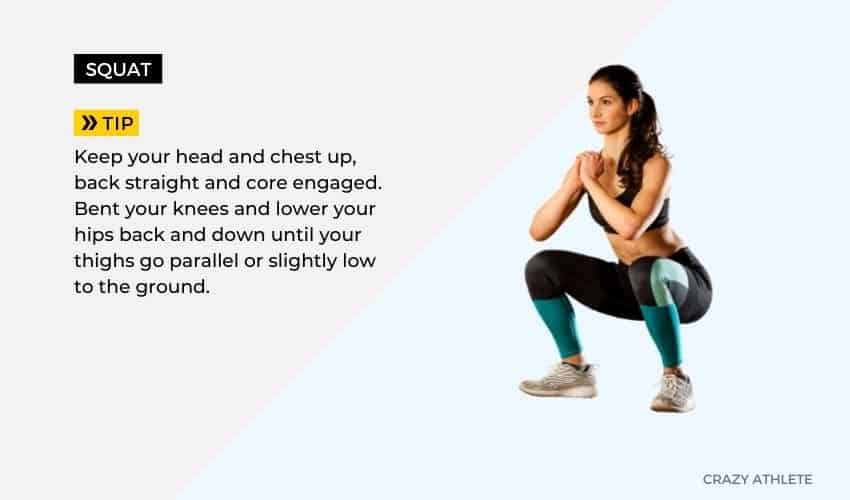
How to do it:
- Stand with your feet together and hands in your side.
- Little jump, stretch your feet slightly wider than shoulder-width apart, lower your hips back down, and make your thighs 90-degree angle or slightly below.
- Jump up to the starting position. Repeat.
Why: Squat is an effective exercise to train your legs and glutes. It’s one of the best exercises to increase your lower body’s muscular endurance.
Lunge
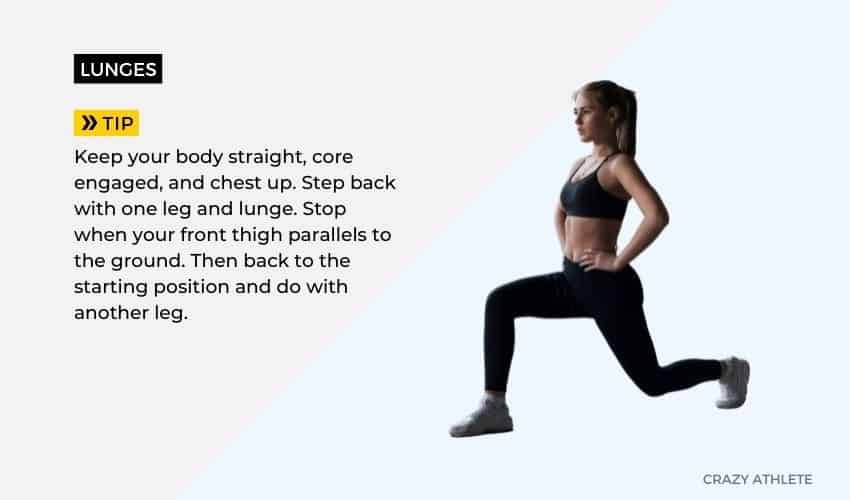
How to do it:
- Stand with your feet together and hands at your hips.
- Keeping your core tight and chest up, step back your right leg and lunge. Stop when your left thigh parallels to the ground. Make sure you are putting the loads on your front leg.
- Push back to the starting position, then stepping back your left leg and repeat the same. Perform the desired reps.
Why: First of all, the lunge is an effective exercise to improve your overall body balance and control. It hit your squats, hamstring, and hip muscles — makes your lower body stronger.
Abdominal Crunch
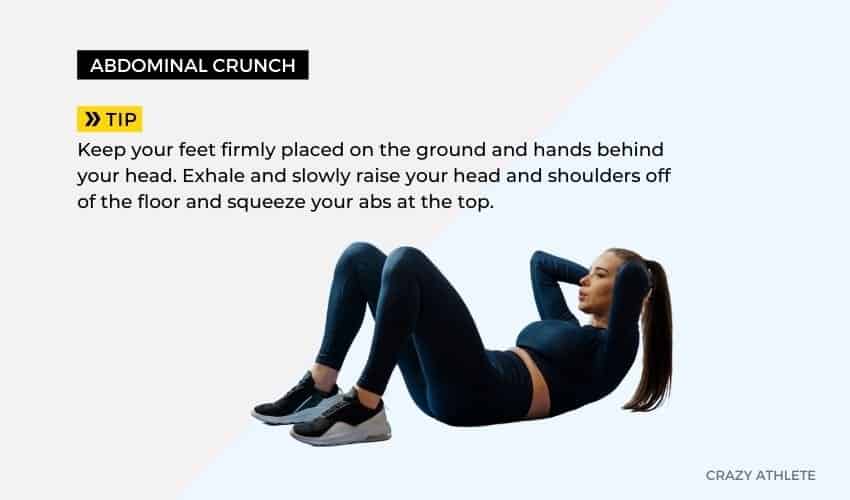
How to do it:
- Lie on your back, keeping your leg bent at a 60-degree angle and your hands behind your head.
- Exhale and up your head with the help of your hands and contact the core muscle at the top.
- Slowly return to the starting position. Repeat.
Why: Sit-up is an easy beginner workout to activate your abdominal area. It mostly targets and helps to increase your core endurance and stamina.
Plank
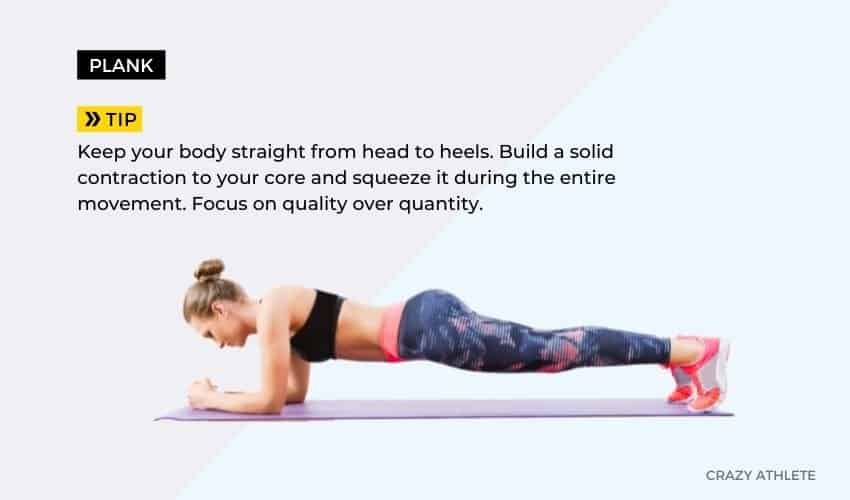
How to do it:
- Place your elbows and toes on the floor, keep your body in a straight line (head to heels).
- Create muscle mind connection with your abdominal muscle.
- Squeeze your core and hold them for atleast 20-30 seconds or as much as you can.
Why: Plank is a crucial exercise to build core and spine strength and increase abdominal muscles’ visibility. It also helps to push your mental capacity.
Conclusion
When the question is how to build endurance, bear in mind that it’s a natural and slow process to experience.
So, don’t expect a fast result and avoid pushing yourself to the point of exhaustion. Regular exercise with the right diet and adequate rest is crucial to building endurance.
Now, I want to know how excited you are to improve your endurance?
And, why do you want to build endurance?
Just drop a comment below. I’ll love to hear from you!
